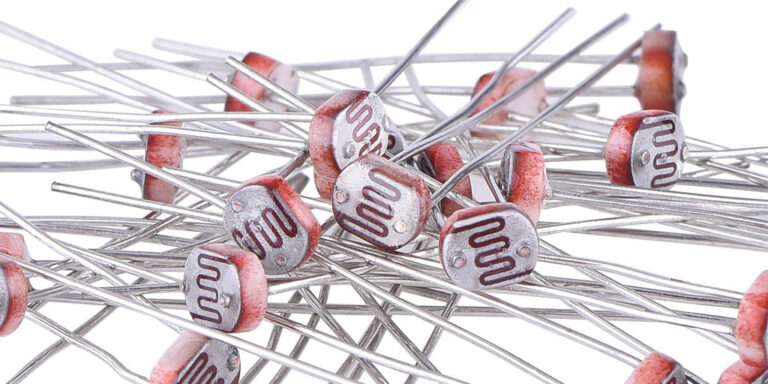The GL5537 LDR is made up of a semiconductor material with a high resistance in the dark and low resistance in the light.
Table of contents
Introduction to GL5537 LDR photo-sensitive resistors
GL5537 is a type of photoresistor or light-dependent resistor (LDR) that has gained popularity for its use in various electronic and electrical applications. It is a passive microelectronic component that changes its resistance in response to changes in light intensity.
GL5537 LDR photo-sensitive resistors are readily available and can be easily incorporated into home automation or home security projects using analogue pins on a microcontroller.
In this post the reader will see what a photo-sensitive resistor is, what makes the GL5537 LDR photo-sensitive resistor special, use cases and example code for the Arduino IDE. It also mentions the required accessories for developing with GL5537 LDR photo-sensitive resistors.
- Get the GL5537 LDR Photo-Sensitive Resistor from Amazon.com
- Get the Basic Arduino Uno R3 Starter Kit from Amazon.com or BangGood
- Get the Microelectronics Starter Kit from Amazon.com or BangGood
What is a photo-sensitive resistor?
Photo-sensitive resistors are also referred to as light-dependent resistors (LDR), photoresistors or photocells. A photo-sensitive resistor is a light-controlled variable resistor where the resistance decreases with increasing light intensity and vice versa. In the field of microelectronics, the difference or the value of the resistance can be recorded and used by microcontrollers for output logic.
The GL5537 LDR is made up of a semiconductor material with a high resistance in the dark and low resistance in the light. When the LDR is exposed to light and its resistance decreases, more current can flow through the circuit. In other words, the amount of current that passes through the circuit depends on the amount of light falling on the LDR.
Photo-sensitive resistors are widely used in commercial toys, lamps, cameras and other products, but are also perfect to use by microelectronic hobbyists and engineers.
What makes the GL5537 LDR photo-sensitive resistor so special?
One of the primary advantages of the GL5537 LDR is its ability to sense light and respond quickly to changes in light intensity. This feature makes it useful in a wide range of applications, including streetlights, cameras, light meters, and automatic doors.
In streetlights, for example, the GL5537 LDR can detect changes in the ambient light levels and automatically turn on/off the lights as necessary. Similarly, in cameras, the LDR can adjust the shutter speed and aperture to capture the perfect image in different lighting conditions.
The GL5537 LDR is also widely used in light meters, where it measures the intensity of light and converts it into an electrical signal. This signal is then used to adjust the settings of the camera, ensuring the optimal exposure of the photograph.
GL5537 LDR photo-sensitive resistors are fairly cheap and easily obtainable. They can be bought in bulk and are easy to connect to a microcontroller such as an Arduino using its analogue pins.
GL5537 LDR photo-sensitive resistor specifications
May vary
Pins: 2
Signalling: Analogue
Max input voltage: 150 V DC
Max Wattage: 100 mW
Operating temperature: -30 ~ 70 °C
Spectral peak: 540 nm
Bright resistance (10 Lux) (KΩ): 20 – 230
Dark resistance: 2 MΩ
100λ10: 0.6
Response time: 20 ms (rise), 30 ms (fall)
Resistance illumination: 4
Breadboard friendly: yes
Pin size: male
Example code for the Arduino IDE and GL5537 LDR photo-sensitive resistors
GL5537 LDR photo-sensitive resistors are easy to connect to a microcontroller such as an Arduino using its analogue pins. Here is an example of the code that can be used with the Arduino IDE:
const int ldrPin = A0; // LDR connected to analog pin A0
const int ledPin = 13; // LED connected to digital pin 13
int ldrValue = 0; // variable to store LDR value
void setup() {
pinMode(ledPin, OUTPUT); // set LED pin as output
Serial.begin(9600); // initialize serial communication
}
void loop() {
ldrValue = analogRead(ldrPin); // read LDR value
Serial.println(ldrValue); // print LDR value to serial monitor
if (ldrValue > 500) { // if LDR value is above 500
digitalWrite(ledPin, HIGH); // turn on LED
} else { // if LDR value is below 500
digitalWrite(ledPin, LOW); // turn off LED
}
delay(500); // wait for 500 milliseconds before reading LDR again
}
In this example, the GL5537 LDR is connected to analogue pin A0 on the Arduino board. The LED is connected to digital pin 13.
The setup() function sets the LED pin as an output and initializes the serial communication.
In the loop() function, the LDR value is read using the analogRead() function and stored in the ldrValue variable. The LDR value is printed to the serial monitor using the Serial.println() function.
If the LDR value is above 500, indicating that the ambient light is low, the LED is turned on using the digitalWrite() function. If the LDR value is below 500, indicating that the ambient light is high, the LED is turned off. The delay() function is used to wait for 500 milliseconds before reading the LDR value again.
Recommended accessories for GL5537 LDR photo-sensitive resistors
- 10 – 20k Ohm resisters Amazon.com or BangGood
- A breadboard for prototyping Amazon.com or BangGood
- Solderless breadboard jumper cable set for prototyping Amazon.com or BangGood
- Get the Basic Arduino Uno R3 Starter Kit from Amazon.com or BangGood
- Get the Microelectronics Starter Kit from Amazon.com or BangGood
Conclusion
The GL5537 LDR is a versatile and reliable component that is widely used in various electronic and electrical applications. Its ability to sense and respond to changes in light intensity makes it an essential component in many devices.
This post discussed the GL5537 LDR photo-sensitive resistors, use cases and gave example code for the Arduino IDE. It also mentioned the required accessories for developing with GL5537 LDR photo-sensitive resistors.

